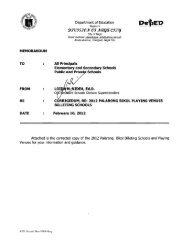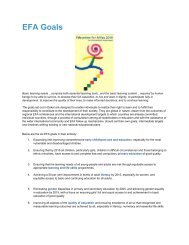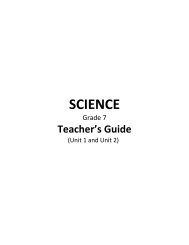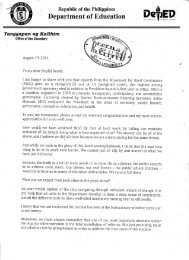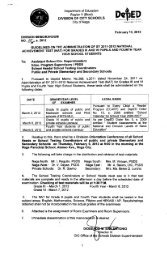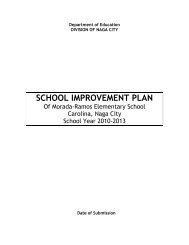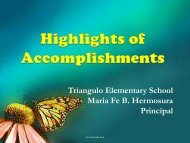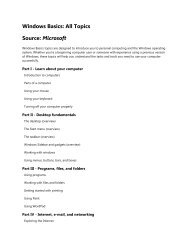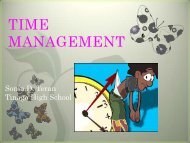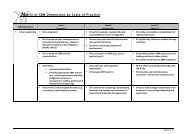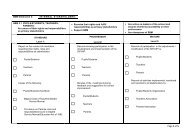K to 12 Curriculum Guide SCIENCE - DepEd Naga City
K to 12 Curriculum Guide SCIENCE - DepEd Naga City
K to 12 Curriculum Guide SCIENCE - DepEd Naga City
You also want an ePaper? Increase the reach of your titles
YUMPU automatically turns print PDFs into web optimized ePapers that Google loves.
Content<br />
Substances and.<br />
Mixtures<br />
Elements and<br />
Compounds<br />
Metals and<br />
Nonmetals<br />
The learner…<br />
<br />
<br />
K TO <strong>12</strong> <strong>SCIENCE</strong><br />
Content Standards Performance Standards Learning Competencies<br />
demonstrates understanding of<br />
the properties of substances<br />
which distinguish them from<br />
mixtures.<br />
demonstrates understanding of<br />
classifying substances as<br />
elements or compounds and<br />
distinguishes between metals<br />
and nonmetals.<br />
GRADE 7 - Living Things and Their Environment<br />
SECOND QUARTER/SECOND GRADING PERIOD<br />
Parts and Functions<br />
The learner…<br />
<br />
chooses appropriate materials<br />
available in the community for<br />
specific purposes.<br />
The learner…<br />
<br />
<br />
<br />
<br />
<br />
<br />
<br />
recognizes that a substance has a unique<br />
set of properties.<br />
investigates the properties of mixtures of<br />
varying concentrations.<br />
recognizes that substances are classified<br />
in<strong>to</strong> elements and compounds.<br />
recognizes that compounds consist of<br />
specific elements<br />
gather information about common<br />
elements such as names, symbols and<br />
whether it is a metal or nonmetal from a<br />
Periodic Table<br />
demonstrates the different properties of<br />
metals and nonmetals such as luster,<br />
malleability, ductility, and conductivity.<br />
recognizes the elements considered as<br />
metals and those that are nonmetals.<br />
<br />
<br />
<br />
<br />
Levels of organization<br />
Microscopy<br />
Animal and plant cells<br />
Microorganisms:<br />
Fungi, Protists, and<br />
Bacteria<br />
<br />
<br />
demonstrates understanding of<br />
the different levels of<br />
organization<br />
demonstrates understanding<br />
that aside from plants and<br />
animals, there are other much<br />
smaller organisms that can only<br />
be seen through the<br />
microscope; many of which<br />
consist of only one cell<br />
<br />
<br />
employs appropriate techniques<br />
using standard <strong>to</strong>ols or equipment <strong>to</strong><br />
gather data about very small objects<br />
recognizes that many organisms,<br />
including humans, have organ<br />
systems that work <strong>to</strong>gether <strong>to</strong> carry<br />
out essential processes of the body<br />
<br />
<br />
<br />
differentiates organ systems, organs,<br />
tissues, cells from each other<br />
identifies parts of the microscope and<br />
their functions<br />
differentiates plant and animal cells<br />
according <strong>to</strong> presence or absence of<br />
certain organelles<br />
K <strong>to</strong> <strong>12</strong> <strong>Curriculum</strong> <strong>Guide</strong> Science – version as of January 31, 20<strong>12</strong> 11




